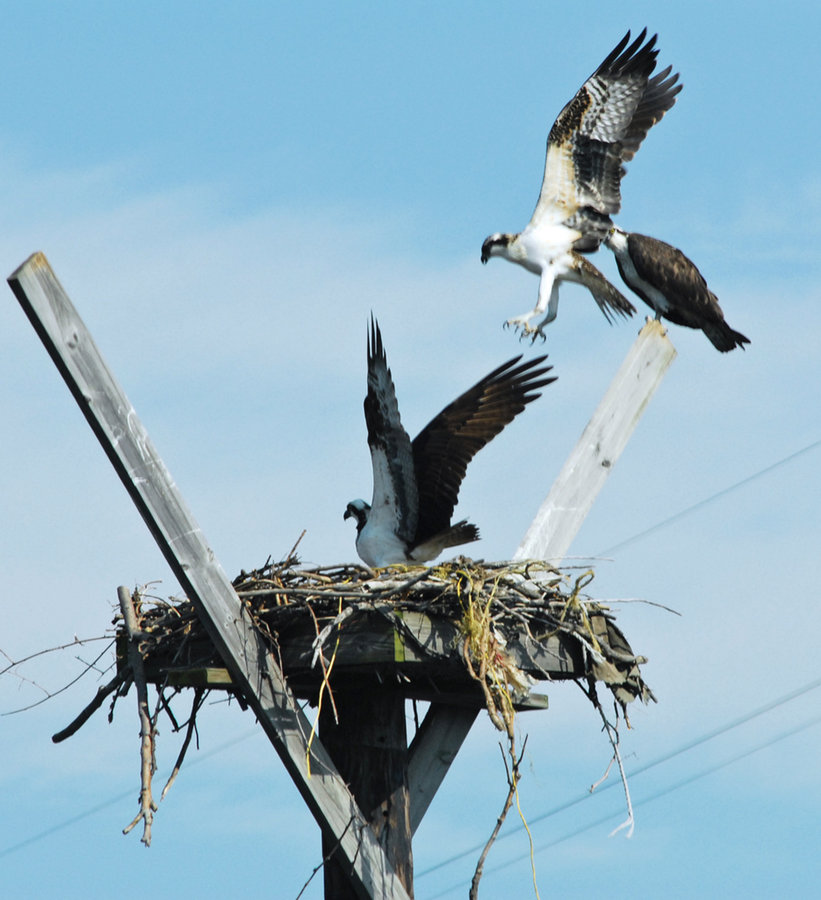From a distance, you might not be able to see them, but the raptors have returned to Hudson Generating Station in Jersey City, said Rich Dwyer, of PSE&G. These are nesting osprey that until a little more than a decade ago had abandoned the Meadowlands and the Hackensack River because the area had become too polluted to sustain much of the wildlife
Dwyer said PSE&G along with the Hackensack Riverkeeper teamed up to construct and install the first osprey platforms in the area.
“They (osprey) had not successfully nested in the Hackensack River Watershed in an estimated 75 to 100 years,” he said.
According to Hackensack Riverkeeper Captain Hugh Carola, there are seven nesting pairs of osprey along the lower Hackensack River. There are nests in Teaneck, Carlstadt, two in Lyndhurst, two in Kearny, and the pioneer nest on the grounds of PSEG’s Hudson Generating Station in Jersey City.
The osprey nest platform building started when Capt. Bill Sheehan, the first Hackensack Riverkeeper, reached out to PSE&G in 1995.
“They (Osprey) had not successfully nested in the Hackensack River Watershed in an estimated 75 to 100 years.” — Hugh Carola
____________
The Hackensack Riverkeeper is an environmental organization that protects the Hackensack River and surrounding wetlands through advocacy, education, and conservation programs. But
PSE&G is also known for its involvement in efforts like this and for minimizing the company’s impact on threatened and endangered species.
The osprey – sometimes called a sea hawk – is a large raptor that breeds by freshwater lakes, and sometimes on coastal brackish waters. Natural nests could be comprised of sticks, driftwood, and seaweed in outcrops of rocks or even utility poles or artificial platforms. The platform design currently in use by PSE&G was developed by Citizens United to Protect the Maurice River and Its Tributaries, Inc. which has since become the official design of the State of New Jersey, but are used worldwide.
The cycle of life
In spring the pair begins a five-month period of partnership to raise their young.
“In February to March, ospreys return to the region,” Carola said. “Birds that have formerly nested return to those exact spots and call for their mates. If the mates have survived their migratory journeys, they will return, respond and re-bond with their mates. It’s not so much that they love each other, but that they love the successful nesting site.”
The female lays two to four eggs within a month, and relies on the size of the nest to conserve heat. The eggs are incubated for about five weeks to hatching. Osprey are at the top of the marine food chain, indicating that the local water quality is healthy enough to support a growing fish population for the “fish hawk.”
Osprey, or “fish hawks,” are on New Jersey Department of Environmental Protection (NJDEP)’s list of endangered and/or non-game animals. Since they only eat fish, they have to be in areas with non-contaminated fish.
At first, if you don’t succeed…
The first nesting pair was in 2006 at Hudson Generation plant in Jersey City. The nest failed due to gull predation. The mating pair attempted to set up in one of the nests where they ultimately laid eggs. But being inexperienced parents, both left the nest allowing other predators access to them.
Experienced parents leave the nest in shifts, with one adult guarding the nest at all times.
Prior to the 1990s, pollution in the Meadowlands has kept endangered osprey birds from living and breeding in the area. People saw the spotted raptor flying in other parts of New Jersey, but it wasn’t until 2007 that the Riverkeeper caught on video tape the first baby birds using a nest that had been installed a few years prior to that – a combined project that included The Riverkeeper and PSE&G.
“From 2007, when that nesting pair successfully raised the first pair of osprey chicks along the river in anyone’s memory, we have seen a remarkable sevenfold increase and we can certainly expect even more,” Carola said. “There are several factors that have contributed to the success: the Clean Water Act and other federal and state protections since the 1970s, the 2004 Meadowlands Master Plan that protected all 8,400 acres of wetlands and waterways within the district, the recovery of the river’s fish populations due to cleaner water, and property owners like PSE&G that have welcomed nesting raptors with nest platforms.”
Although obvious in the mid-1990s that the Meadowlands were making a comeback, a 2003 study showed the increased populations of marine life in the area, paving the way for the return of the raptors.
“What this means is proof positive that the ecology of the lower Hackensack Watershed/Meadowlands District has recovered to a great extent such that it supports seven nesting pairs of osprey as well as three pairs of Peregrine Falcons, two pairs of Red-tailed Hawks, two pairs of barn owls, one pair of bald eagles, and probably one or two pairs of Northern Harriers,” Carola said. “Seeing such a concentration of successfully-reproducing avian predators along with so many other nesting, foraging, migrating and overwintering birds proves what valuable habitat exists in our region.”
PSE&G has since teamed up in other parts of Hudson County and recently helped install osprey next with the help of Bayonne High School ant the Bayonne Golf Club.
Al Sullivan may be reached at asullivan@hudsonreporter.com.
